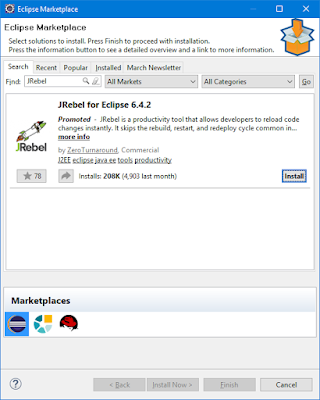

- JREBEL DOWNLOAD ECLIPSE PLUGIN HOW TO
- JREBEL DOWNLOAD ECLIPSE PLUGIN PASSWORD
The web application will be accessible under the context path sample-app.įurthermore, you can set the following optional task properties: To enable SSL we set the property enableSSL to true.
JREBEL DOWNLOAD ECLIPSE PLUGIN HOW TO
The following example code shows how to change the default HTTP/HTTPS ports. Used to configure tomcat with basic authentication
JREBEL DOWNLOAD ECLIPSE PLUGIN PASSWORD
users: List of users with username, password and roles.ajpProtocol: The AJP protocol handler class name to be used (defaults to .AjpProtocol).

 httpsProtocol: The HTTPS protocol handler class name to be used (defaults to 11.Http11Protocol). httpProtocol: The HTTP protocol handler class name to be used (defaults to 11.Http11Protocol). keystoreFile: The keystore file to use for SSL, if enabled (by default, a keystore will be generated). When false, this task blocks until the Tomcat server is stopped (defaults to false). When true, this task completes as soon as the daemon: Specifies whether the Tomcat server should run in the background. enableSSL: Determines whether the HTTPS connector should be created (defaults to false). contextPath: The URL context path under which the web application will be registered (defaults to WAR name). stopKey: The key to pass to Tomcat when requesting it to stop (defaults to null). stopPort: The TCP port which Tomcat should listen for admin requests on (defaults to 8081). ajpPort: The TCP port which Tomcat should listen for AJP requests on (defaults to 8009). httpsPort: The TCP port which Tomcat should listen for HTTPS requests on (defaults to 8443). httpPort: The TCP port which Tomcat should listen for HTTP requests on (defaults to 8080). The Tomcat plugin exposes the following properties through the extension named tomcat: The Tomcat plugin uses the same layout as the War plugin. Runs the JSP compiler and turns JSP pages into Java source using Jasper. Starts a Tomcat instance and deploys the WAR to it. Starts a Tomcat instance and deploys the exploded web application to it. The plugin pre-defines the following tasks out-of-the-box: Task Name HttpProtocol = '11.Http11Nio2Protocol 'ĪjpProtocol = '.AjpNio2Protocol ' The following code snippet shows an example on how to retrieve it: It is directly available on the Gradle plugin portal. The plugin JAR needs to be defined in the classpath of your build script. To use the plugin's functionality, you will need to add the its binary artifact to your build script's classpath and apply the plugin. You are looking for this capability, please have a look at the Cargo plugin This plugin also can't deploy a WAR file to a remote container. The container cannot be forked as a separate process.
httpsProtocol: The HTTPS protocol handler class name to be used (defaults to 11.Http11Protocol). httpProtocol: The HTTP protocol handler class name to be used (defaults to 11.Http11Protocol). keystoreFile: The keystore file to use for SSL, if enabled (by default, a keystore will be generated). When false, this task blocks until the Tomcat server is stopped (defaults to false). When true, this task completes as soon as the daemon: Specifies whether the Tomcat server should run in the background. enableSSL: Determines whether the HTTPS connector should be created (defaults to false). contextPath: The URL context path under which the web application will be registered (defaults to WAR name). stopKey: The key to pass to Tomcat when requesting it to stop (defaults to null). stopPort: The TCP port which Tomcat should listen for admin requests on (defaults to 8081). ajpPort: The TCP port which Tomcat should listen for AJP requests on (defaults to 8009). httpsPort: The TCP port which Tomcat should listen for HTTPS requests on (defaults to 8443). httpPort: The TCP port which Tomcat should listen for HTTP requests on (defaults to 8080). The Tomcat plugin exposes the following properties through the extension named tomcat: The Tomcat plugin uses the same layout as the War plugin. Runs the JSP compiler and turns JSP pages into Java source using Jasper. Starts a Tomcat instance and deploys the WAR to it. Starts a Tomcat instance and deploys the exploded web application to it. The plugin pre-defines the following tasks out-of-the-box: Task Name HttpProtocol = '11.Http11Nio2Protocol 'ĪjpProtocol = '.AjpNio2Protocol ' The following code snippet shows an example on how to retrieve it: It is directly available on the Gradle plugin portal. The plugin JAR needs to be defined in the classpath of your build script. To use the plugin's functionality, you will need to add the its binary artifact to your build script's classpath and apply the plugin. You are looking for this capability, please have a look at the Cargo plugin This plugin also can't deploy a WAR file to a remote container. The container cannot be forked as a separate process. 
Gradle starts the embedded container in the same JVM. The plugin allows for rapid web applicationĭevelopment due to the container's fast startup times. The typical use case for this plugin is to support deployment during development. At the moment the Tomcat versionsĦ.0.x, 7.0.x, 8.0.x, 8.5.x and 9.0.x are supported. The plugin provides deployment capabilities of web applications to an embedded Tomcat web container in any given Plugin continue to thrive, shoot me a mail. If you are interested and would love to see this Willing to take on maintenance and implementation of the project. Responsiveness on issues and new releases from my end. In practice this means far less activity, Unfortunately, I don't have much time to contribute anymore. Over the past couple of years this plugin has seen many releases.








 0 kommentar(er)
0 kommentar(er)
